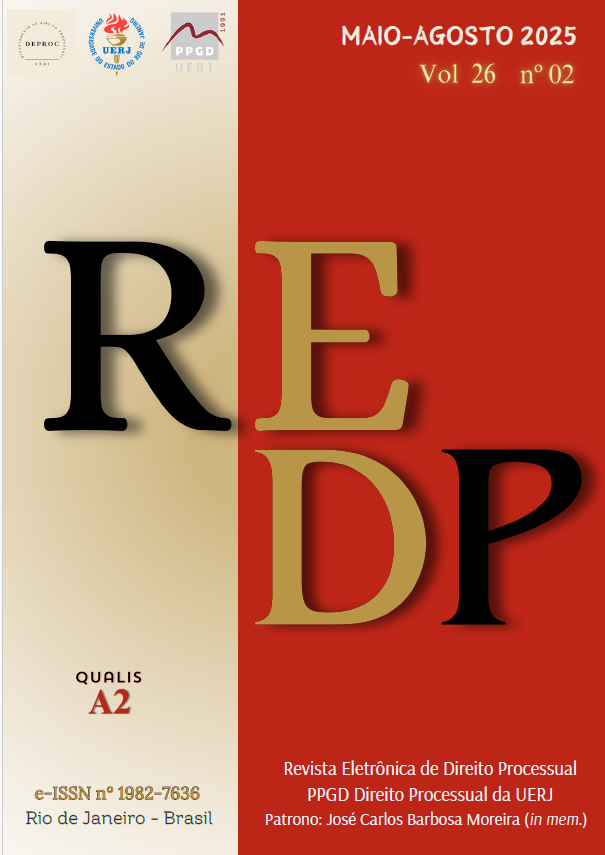Features of mediation as an alternative method of settlement of family disputes: Legal provision and practice in Ukraine and EU countries
DOI:
https://doi.org/10.12957/redp.2025.90138Resumo
Family mediation is an effective alternative dispute resolution method that plays a crucial role in settling family conflicts outside the courtroom. The growing demand for mediation in Ukraine and the EU reflects the need for a more efficient, cost-effective, and confidential approach to resolving family disputes. This study aims to analyze the legal framework and practical implementation of family mediation in Ukraine and selected EU countries, highlighting its advantages and potential for further development. The research employs a comparative legal method, doctrinal analysis, and case study methodology to assess the current regulatory framework and practical applications of family mediation. The findings indicate that while Ukraine has made significant progress in establishing mediation as a legal practice, gaps remain in its legislative framework, enforcement mechanisms, and public awareness. In contrast, EU countries demonstrate a well-developed system of family mediation, often supported by mandatory pre-trial mediation requirements and state-funded mediation services. The study concludes that Ukraine can benefit from adopting best practices from the EU, particularly in integrating mediation into the legal system, ensuring its accessibility, and enhancing mediator training programs. The scientific novelty of the research lies in its comprehensive analysis of family dispute mediation, as well as its recommendations for strengthening Ukraine’s mediation infrastructure in alignment with European standards.
Downloads
Publicado
Como Citar
Edição
Seção
Licença
Copyright (c) 2025 Olga Tymoshenko, Iryna Petrova

Este trabalho está licenciado sob uma licença Creative Commons Attribution 4.0 International License.
Todos os artigos publicados na Revista Eletrônica de Direito Processual (REDP) (Departamento de Direito Processual, Universidade do Estado do Rio de Janeiro, Brasil) são licenciados por meio de uma Licença Creative Commons - Atribuição 4.0 Internacional (CC BY 4.0).
Os autores retêm os direitos autorais de seu artigo e concordam em licenciar seu trabalho com a licença CC BY 4.0, aceitando assim os termos e condições específicos desta licença disponíveis no seguinte website: https://creativecommons.org/licenses/by/4.0/legalcode.
- Os autores concedem à REDP o direito de primeira publicação, de se identificar como publicadora original do trabalho e concedem à revista uma licença de direitos não exclusivos para utilizar o trabalho das seguintes formas: Reproduzir, vender e distribuir cópias eletrônicas ou impressas do manuscrito como um todo, de partes específicas do manuscrito e de suas traduções para qualquer idioma;
- O uso do artigo por terceiros é livre, contanto que a integridade da publicação seja mantida e seus autores originais, periódico de primeira publicação e detalhes de citação sejam identificados.
Dentro dos termos da licença, os autores podem entrar em acordos contratuais adicionais separados para a distribuição não exclusiva da versão publicada do trabalho na revista.
Copyright and Licensing
All articles published in the Procedural Law Electronic Review (REDP) (Department of Procedural Law, State University of Rio de Janeiro, Brazil) are licensed under a Creative Commons License - Attribution 4.0 International (CC BY 4.0).
- Authors retain copyright to their article and agree to license their work under the CC BY 4.0 license, thereby accepting the specific terms and conditions of this license available at the following website: https://creativecommons.org/licenses/by/4.0/ legal code.
- Authors grant REDP the right of first publication, to identify itself as the original publisher of the work, and grant the journal a non-exclusive license to use the work in the following ways: Reproduce, sell and distribute electronic or printed copies of the manuscript as a whole, of specific parts of the manuscript and its translations into any language;
- Use of the article by third parties is free, as long as the integrity of the publication is maintained and its original authors, first publication journal, and citation details are identified.
Within the terms of the license, authors may enter into separate additional contractual agreements for the non-exclusive distribution of the published version of the work in the journal.




